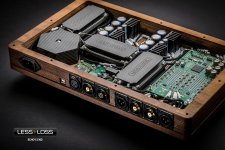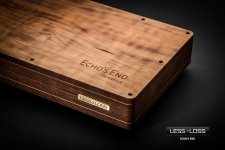Hi,
I have some nice extra wood for Lampucera dac chassis, but this is not "usual" thing to do so asking can it work?
-If i use Aluminium foil tape for sides inside, it should work right?
-Should i make "double layer" of copper tape over aluminium?
I have some nice extra wood for Lampucera dac chassis, but this is not "usual" thing to do so asking can it work?
-If i use Aluminium foil tape for sides inside, it should work right?
-Should i make "double layer" of copper tape over aluminium?
Copper foil would be easier to work with as you can solder on it , GND.
In a dac the transformer won't get hot.
I'm looking to make a wood enclosure for an audio amp, planning to use some heat resistant, isolator material between the wood and a sheet of metal and on that I will bolt the transformer, with some holes for air flow I ca not see why it won't work or look awesome ! .
Old vintage equipment was made in wooden enclosures .
In a dac the transformer won't get hot.
I'm looking to make a wood enclosure for an audio amp, planning to use some heat resistant, isolator material between the wood and a sheet of metal and on that I will bolt the transformer, with some holes for air flow I ca not see why it won't work or look awesome ! .
Old vintage equipment was made in wooden enclosures .
Copper foil is mostly effective for high frequency radiated EMI/RFI. If the copper is in the range of a few to several skin-depths thick at the lowest frequency of interest, then it can be effective. However, if there are holes in the copper shielding then there can still be EMI/RFI ingress problems by way of the holes. Good to pick up a book on "electromagnetic compatibility engineering" for more detailed info. The book by Henry Ott is very good and mostly practically oriented.
Also, often its better to use steel instead of copper. 18 gauge steel is good for LF fields as well as HF fields. However, if using steel maybe good to keep sensitive circuitry at least 2" away from the steel itself.
The basic difference between copper and steel is that copper is reflective and steel is lossy. Also, the skin depth in steel is much thinner than in copper.
Also, often its better to use steel instead of copper. 18 gauge steel is good for LF fields as well as HF fields. However, if using steel maybe good to keep sensitive circuitry at least 2" away from the steel itself.
The basic difference between copper and steel is that copper is reflective and steel is lossy. Also, the skin depth in steel is much thinner than in copper.
So if it is possible, there should not be holes in dac chassis for best performance?
(A bit hard in tube dac, but maybe possible with some copper elements that radiates "outside" of chassis)
(A bit hard in tube dac, but maybe possible with some copper elements that radiates "outside" of chassis)
Personally I think you are trying to solve a problem that does not exist. Unless you live near a transmitter/radar facility.
So just like lessloss don't bother.
Most CD players and DACs have plastic fronts and backs...so effectively have no shielding either.
So just like lessloss don't bother.
Most CD players and DACs have plastic fronts and backs...so effectively have no shielding either.
Does this cover a situation where you cannot use unshielded rca cables?
I live in a city, where i only can use shielded cables, so that is why i am asking..
Edit: Now that i think about it, i have used a dac in here with open top when experimenting so it definitely works.
Problem is i like to tune and hassle about these kind of things, so i think i will go for compromise:
-Use copper tape inside but punch as many holes as is needed..
I live in a city, where i only can use shielded cables, so that is why i am asking..
Edit: Now that i think about it, i have used a dac in here with open top when experimenting so it definitely works.
Problem is i like to tune and hassle about these kind of things, so i think i will go for compromise:
-Use copper tape inside but punch as many holes as is needed..
There is no harm in shielding your wooden box. I just never have done it and never had problems.
I obviously don't know the rf situation in your area. Nor am I an electronics engineer. Just a fellow diy'er making a suggestion.
Perhaps you build can your dac on a wooden plank...so you can have a layout and size. And get it up and running and determine for yourself if you need shielding or not with your equipment and location.
I obviously don't know the rf situation in your area. Nor am I an electronics engineer. Just a fellow diy'er making a suggestion.
Perhaps you build can your dac on a wooden plank...so you can have a layout and size. And get it up and running and determine for yourself if you need shielding or not with your equipment and location.
Last edited:
I will do some comparative testing when i build it, just to see if there is some improvement with moderate shielding.
The reason for shielding is not just as a fix for picking up local radio stations. A DECT cordless phone base station within 10-15 feet is good for producing FFT spurs every 100Hz. It may not sound like what you might expect either. Problems with radiated and conducted EMI/RFI can cause such symptoms as "grainy" or "veiled sound, as Bill Whitlock has described in the attached.
Besides the work of Whitlock, I would very much encourage anyone developing diy skills to read this: https://www.amazon.com/Electromagne...MI7qvE7OD2gwMVkwitBh3QVgxpEAQYASABEgJDv_D_BwE Maybe a used version could be found with a little searching.
Besides the work of Whitlock, I would very much encourage anyone developing diy skills to read this: https://www.amazon.com/Electromagne...MI7qvE7OD2gwMVkwitBh3QVgxpEAQYASABEgJDv_D_BwE Maybe a used version could be found with a little searching.
Attachments
There is more environmental EMI/RFI noise than ever before, given wi-fi, cell phones, etc. Some people notice the resulting problems, others don't.
If you know who Iancanada is, he makes some shielding and isolation products. Are they needed? IME they are, those things and more.
If you know who Iancanada is, he makes some shielding and isolation products. Are they needed? IME they are, those things and more.
- Home
- Source & Line
- Digital Line Level
- Diy chassis out of wood, what is needed to make it work?

